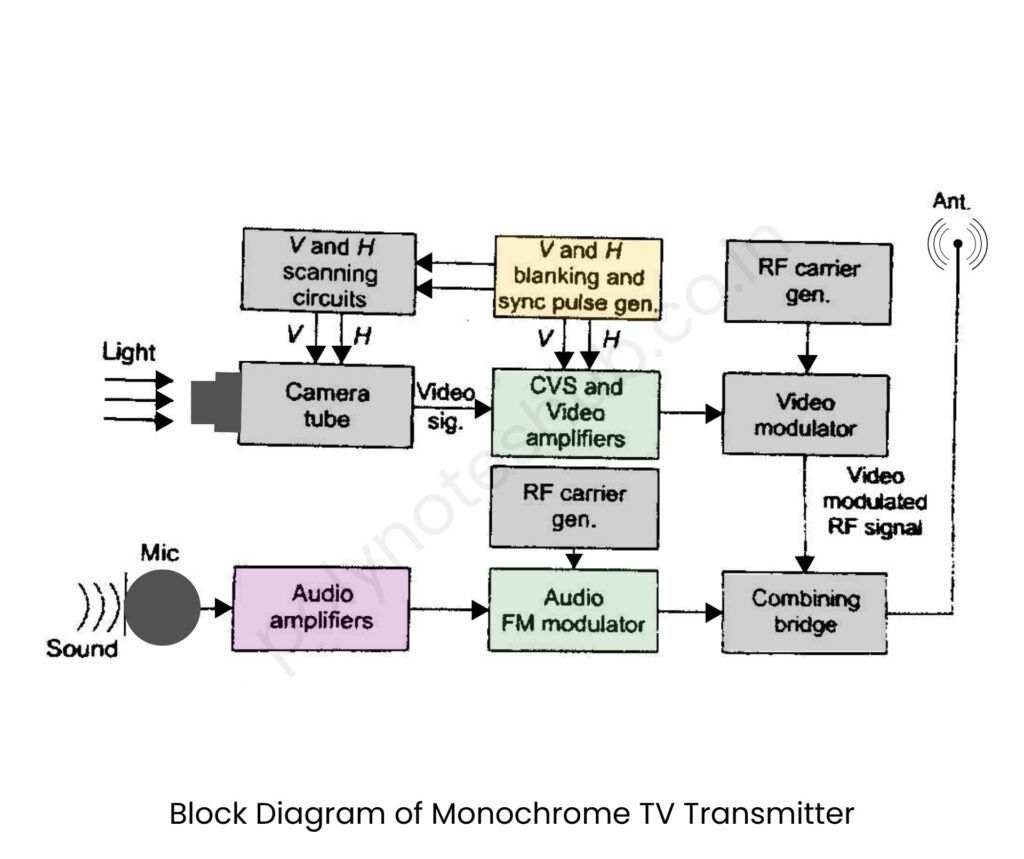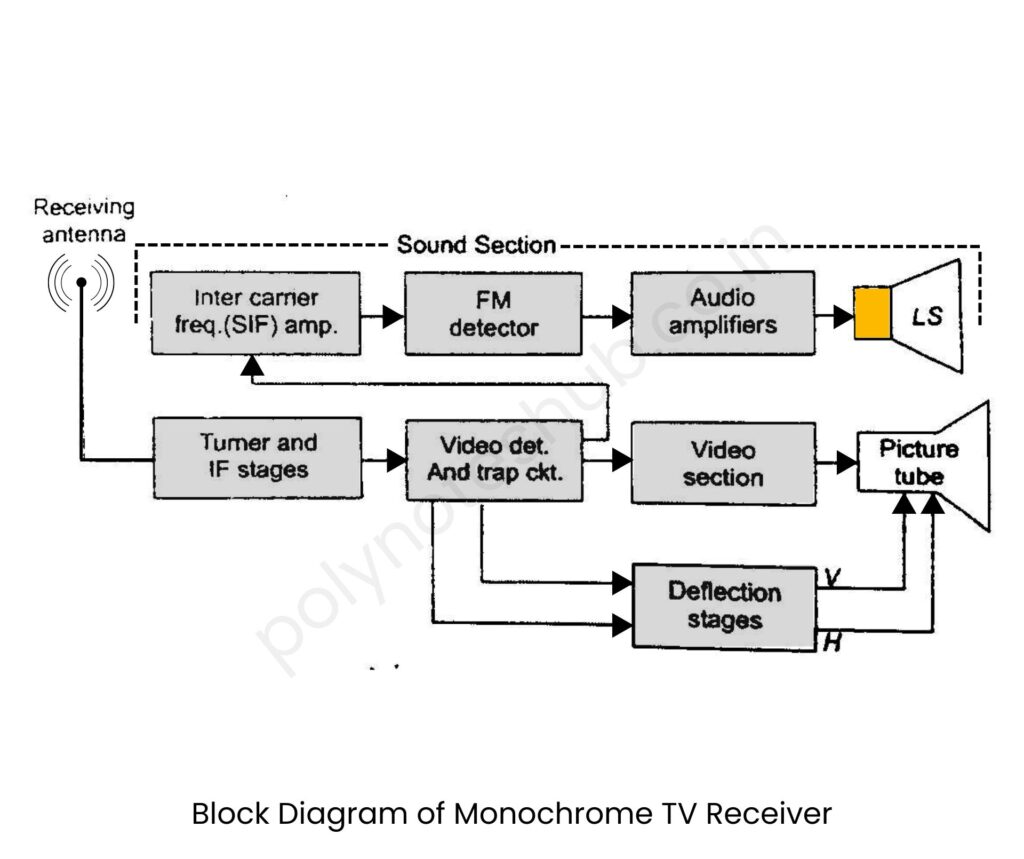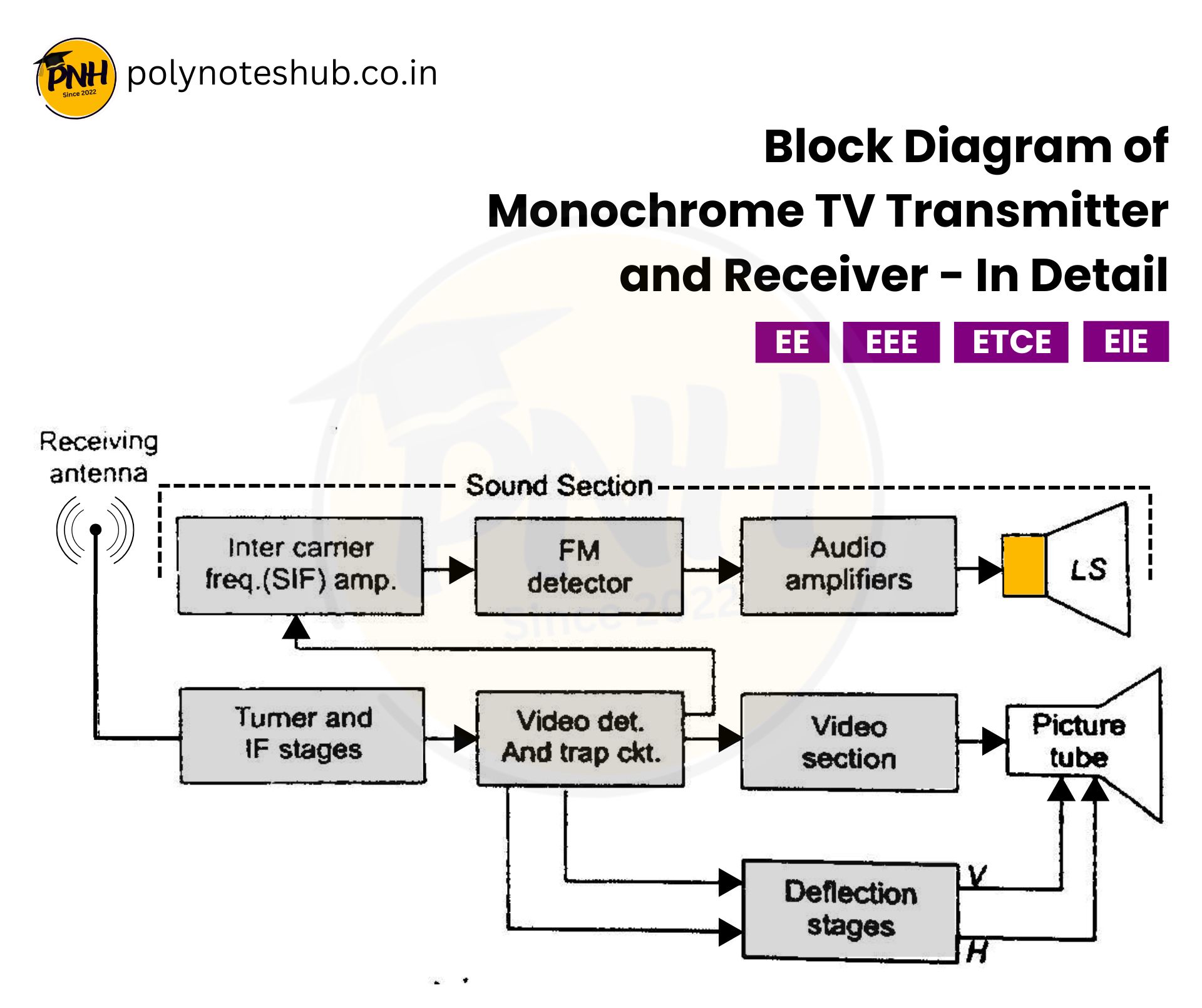In this note, we are going to know the Block Diagram of Monochrome TV Transmitter and Receiver. Welcome to Poly Notes Hub, a leading destination for engineering notes for diploma and degree engineering students.
Author Name: Arun Paul.
What is Monochrome TV Transmitter?
A monochrome TV transmitter is an electrical device that sends television signals in black and white (grayscale) without color information. It transforms video and audio streams into modulated radio waves that are subsequently transmitted at a specified frequency for reception by television receivers. The system contains components for visual signal processing, synchronization, modulation, and transmission. It was commonly utilized in early television transmission prior to the introduction of color television.
Key Components on the Block Diagram of Black and White TV Transmitter
- Camera Tube
- Scanning and Sync Circuits
- Blanking and Sync Pulse Generators
- Video Amplifier
- Microphone
- Audio Amplifier
- RF Carrier Generator and Audio Modulator
- Combining Bridge
- and Transmitting Antenna
Below we have discuss the Block Diagram of Monochrome TV Transmitter and Receiver
Block Diagram of Monochrome TV Transmitter
Here we have attached a monochrome TV transmitter block diagram with explanation –

- Camera Tube: Converts intensity of light from a scene into electrical variations, called video signal by using a photosensitive target plate.
- Scanning and Sync Circuits: Electrical current is extracted from the photosensitive target of the camera tube with the help of a scanning beam which is produced by sawtooth currents through horizontal and vertical deflection coils.
- Blanking and Sync Pulse Generators: The start of a sawtooth or sweep current signal is triggered by pulses called sync pulses. The retrace is blanked by blanking pulses and these pulses are periodic and appear for the specified time by using a monostable multivibrator.
- Video Amplifiers: Video signals along with blanking and Sync Pulses, called composite video signals are amplified by using wideband RC coupled amplifier circuits. The RF carrier generator and video modulator are radio frequency modulated by the video signal. Modulation is of Vestigial sideband (VSB) type AM to save the bandwidth. In this type of modulation, one sideband is vestiged to a small fraction of the whole band. In a TV, the lower sideband is vestiged and the upper sideband are carrier are sent in full.
- Microphone: It converts sound pressure variations into electrical variations, called audio signals .
- Audio Amplifiers: These amplify the weak audio signals.
- RF carrier Generator and Audio Modulator: A Radio frequency carrier is generated and is frequency modulated by the audio signals at low level. The radio frequency is then multiplied and amplified to the full level for transmission.
- Combining Bridge: Video modulated and audio modulated signals pass through a combining bridge (also called diplexer circuit) to go to a common transmitting antenna. The bridge prevents audio modulated signals from going to video sections and vice versa to avoid overloading.
- Transmitting Antenna: Video modulated signals and audio modulated signals are fed to the common transmitting antenna which radiates out the modulated signals into space in the form of electromagnetic waves. The antenna is omnidirectional in the horizontal plane.
Applications of Monochrome TV Transmitter
There are many applications of monochrome TV Transmitter –
- Used in old black and white television broadcasting
- Used in CCTV and low cost video transmission system
- Used in educational projects
- and also used in experimental projects in communication engineering.
What is Monochrome TV Receiver?
A monochrome TV receiver is a television that can only display images in one color (typically grayscale or black and white). It was the first type of television technology before color TV became popular. Monochrome televisions were popular until the 1960s, but they were progressively displaced by color television. However, they are still employed in specialized applications such as night vision monitors, medical imaging, and scientific instruments.
Key Components of Monochrome TV Receiver or in the Black and White TV Receiver Block Diagram
- Receiving Antenna
- Tunner
- IF Stages
- Video Detector
- Video Amplifier
- Deflection Stage
- Picture Tube
- Frequency Amplifier
- FM Detector
- Audio Amplifier
- Loudspeaker
Explain Block Diagram of Monochrome TV Receiver
The basic elements of a monochrome TV receiver are shown in Fig and this is the monochrome TV receiver block diagram –

- Tuner and IF Stages: The receiver is a superheterodyne receiver to achieve high selectivity and high gain. In a superheterodyne receiver, the radio frequency signal, duty amplified by a pre-amplifier, is mixed nonlinearly with the oscillations of higher frequency but of fixed amplitude, generated by a local oscillator. The output of the mixer consists of several intermodulation products, one of which is a signal having a frequency equal to the difference of frequencies of the two signals. The difference frequency is called intermediate frequency, which is selected and amplified. The advantages of the superheterodyne technique are better selectivity and higher gain.
- Video Detector and Trap Circuit: The amplified IF goes to the video detector which recovers video signal from the modulated wave and feeds it to the video amplifier for amplification through the trap circuit, which prevents the video signal from entering into the audio channel.
- Video Amplifiers: These are wideband RC coupled amplifiers. The amplified video signal goes to the picture tube.
- Picture Tube: The video signal varies the strength of the electron beam. This beam strikes the phosphor dots on the fluorescent screen which glow, the intensity of the glow is proportional to the intensity of the video signal.
- Deflection Stages: The phosphor dots glow in quick succession from left to right and top to bottom with the help of scanning currents in the deflection coils. The synchronizing pulses, recovered by the detector, trigger the scanning circuits which produce deflection currents, duly synchronized with the scanning currents used in the transmitter. The deflection currents go to the deflection coils to deflect the electron beam horizontally and vertically on the fluorescent screen to reproduce the picture.
- Sound Section: It consists of a sound IF(SIF) amplifier, FM detector, audio amplifier, and loudspeaker. The difference in frequency between frequency-modulated IF and video carrier IF is called intercarrier frequency, second IF, or sound IF. It is received from the video detector and passes to the SIF amplifier through a trap circuit, which prevents the SIF signal from going into the video amplifier. The FM detector detects the audio signal which is then amplified by audio Amplifiers. The amplified signal goes to the loudspeaker which converts it into sound. Thus, the original sound is reproduced.

